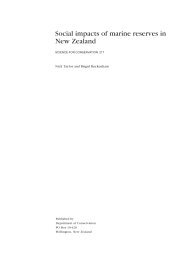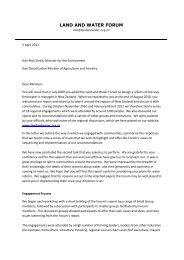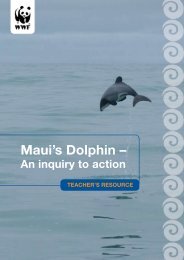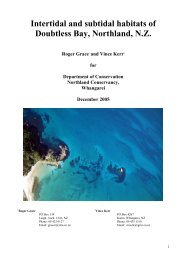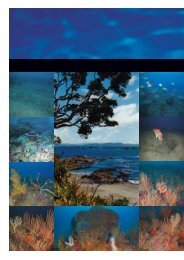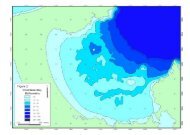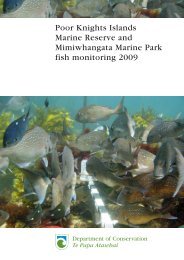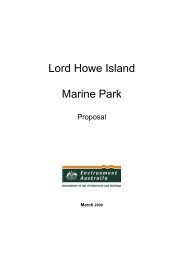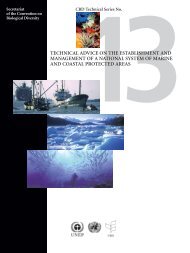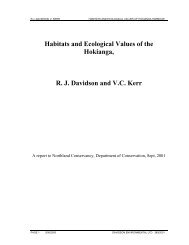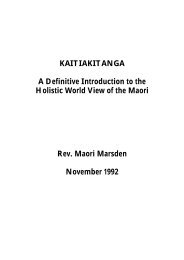WWF Shining a spotlight on the biodiversity of ... - MarineNZ.org.nz
WWF Shining a spotlight on the biodiversity of ... - MarineNZ.org.nz
WWF Shining a spotlight on the biodiversity of ... - MarineNZ.org.nz
You also want an ePaper? Increase the reach of your titles
YUMPU automatically turns print PDFs into web optimized ePapers that Google loves.
The din<strong>of</strong>lagellate, Karenia brevisulcata, a<br />
New Zealand phytoplankt<strong>on</strong> species that<br />
produces a potent toxin.<br />
and Kamykowski<br />
1981). SAW, as<br />
well as being low<br />
in ir<strong>on</strong> and copper<br />
(Sedwick et al.<br />
1997, Croot and<br />
Hunter 1998),<br />
has an excess <strong>of</strong><br />
NO 3<br />
relative to<br />
DRSi (Zentara and<br />
Kamykowski 1981).<br />
The interacti<strong>on</strong> <strong>of</strong><br />
SAW and STW at<br />
<strong>the</strong> STF, especially<br />
over <strong>the</strong> Chatham<br />
Rise, results in<br />
this regi<strong>on</strong> being<br />
highly productive<br />
(Bradford-Grieve<br />
et al. 1999).<br />
In additi<strong>on</strong>,<br />
atmospheric<br />
transport <strong>of</strong> ir<strong>on</strong><br />
from arid and<br />
semi-arid parts <strong>of</strong><br />
Australia may be<br />
a source <strong>of</strong> ir<strong>on</strong> to surface seawater in this<br />
regi<strong>on</strong> (Kieber et al. 2001; Boyd et al. 2004).<br />
It is thought that freshwater is generally<br />
not an important source <strong>of</strong> nutrients <strong>on</strong> <strong>the</strong><br />
open coast, given <strong>the</strong> degree <strong>of</strong> diluti<strong>on</strong><br />
(e.g. Hawke and Hunter 1992). Deep winter<br />
mixing and upwelling <strong>of</strong> deep waters are<br />
more likely to be dominant in enhancing<br />
nutrients in surface waters.<br />
The nutrient c<strong>on</strong>tent <strong>of</strong> <strong>the</strong> oceans has<br />
implicati<strong>on</strong>s for ecosystem structure and<br />
functi<strong>on</strong>. For example, <strong>the</strong> Sou<strong>the</strong>rn Plateau<br />
behaves like a system that is low in nutrients<br />
(despite high NO 3<br />
) and primary producti<strong>on</strong>,<br />
with phytoplankt<strong>on</strong> dominated by very<br />
small cells. It is a low total biomass, low<br />
productivity system with high transfer<br />
efficiency (Bradford-Grieve et al. 2003).<br />
In this regi<strong>on</strong> <strong>the</strong>re is very little <strong>org</strong>anic<br />
matter arriving at <strong>the</strong> sea floor and most<br />
<strong>of</strong> <strong>the</strong> producti<strong>on</strong> occurs in <strong>the</strong> water<br />
column. This system is apparently tightly<br />
coupled. On <strong>the</strong> o<strong>the</strong>r hand, productivity is<br />
much greater in <strong>the</strong> STF over <strong>the</strong> Chatham<br />
Rise, phytoplankt<strong>on</strong> cells are much larger,<br />
and <strong>the</strong>re is much more sedimentati<strong>on</strong> <strong>of</strong><br />
<strong>org</strong>anic matter to <strong>the</strong> sea floor (Nodder and<br />
Northcote 2001).<br />
It is not <strong>on</strong>ly <strong>the</strong> water mass that has<br />
significance for nutrient supply to<br />
phytoplankt<strong>on</strong>. Mesoscale processes that<br />
influence <strong>the</strong> supply <strong>of</strong> nutrients to surface<br />
waters and seas<strong>on</strong>al patterns <strong>of</strong> heating<br />
and cooling (as reflected in <strong>the</strong> depth <strong>of</strong><br />
<strong>the</strong> surface mixed layer) are significant<br />
c<strong>on</strong>tributors to <strong>the</strong> patterns <strong>of</strong> phytoplankt<strong>on</strong><br />
distributi<strong>on</strong> as seen from space as sea colour<br />
(Murphy et al. 2001).<br />
The dynamical signature <strong>of</strong> <strong>the</strong> warmcore<br />
eddies down <strong>the</strong> east coast <strong>of</strong> <strong>the</strong><br />
North Island results in deep, surface winter<br />
mixing (greater than would occur in <strong>the</strong><br />
adjacent water from which <strong>the</strong> eddies<br />
formed (Bradford et al. 1982, Bradford and<br />
Chapman 1988). These eddies c<strong>on</strong>tribute<br />
to enhanced winter nutrient renewal, lower<br />
winter phytoplankt<strong>on</strong> biomass, and are<br />
probably resp<strong>on</strong>sible for <strong>the</strong> generally<br />
extensive spring phytoplankt<strong>on</strong> bloom in<br />
<strong>the</strong> regi<strong>on</strong> (Murphy et al. 2001). Not <strong>on</strong>ly<br />
do <strong>the</strong>se eddies change <strong>the</strong> seas<strong>on</strong>al pattern<br />
<strong>of</strong> nutrient renewal but <strong>the</strong>y can also retain<br />
larvae <strong>of</strong> coastal <strong>org</strong>anisms (Chiswell and<br />
Booth 1999) or entrain coastal water taking<br />
it <strong>of</strong>fshore (Bradford and Chapman 1988).<br />
Winds are important in driving upwellings<br />
that bring nutrient-rich water to <strong>the</strong> surface.<br />
In <strong>the</strong> Sou<strong>the</strong>rn Hemisphere winds blowing<br />
parallel to a coast cause surface waters<br />
to move to <strong>the</strong> left <strong>of</strong> <strong>the</strong> wind. Thus a<br />
northwesterly wind blowing al<strong>on</strong>g <strong>the</strong> coast<br />
north <strong>of</strong> Auckland (Sharples and Greig 1998)<br />
and a southwesterly wind blowing <strong>of</strong>f <strong>the</strong><br />
west coast <strong>of</strong> <strong>the</strong> South Island (Stant<strong>on</strong> and<br />
Moore 1992) will move surface water away<br />
from <strong>the</strong> coast and bring nutrient-rich deeper<br />
water to <strong>the</strong> surface inshore. A c<strong>on</strong>spicuous<br />
summer feature <strong>of</strong> western Cook Strait is a<br />
large upwelling plume that originates from<br />
Kahurangi Point (Bradford-Grieve et al.<br />
©NIWA/Hoe Chang<br />
16 ■ BIODIVERSITY – NEW ZEALAND’S MARINE ECOREGION





